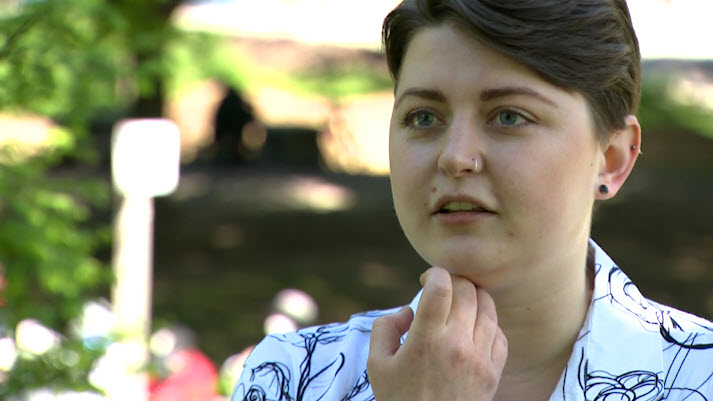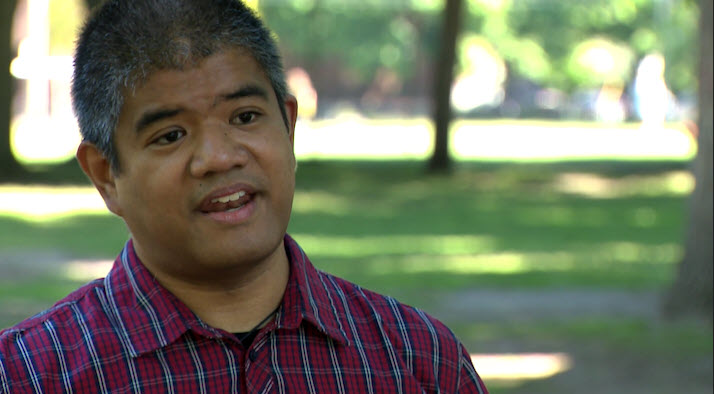
By
Kathryn Mannie
Global News
Published June 18, 2022
9 min read

It wasn’t until Hadley Abrams was 10 that they first heard the word “gay.” And even then it was in the context of I Feel Pretty from Westside Story — they thought it just meant happy.
“I grew up in a time where it was like, ‘Aw that’s so gay’ — that was the insult to use,” Abrams, 27, remembers of growing up in small town Ontario.
FULL COVERAGE: Inside Pride
But they’ve come a long way from that point, Abrams is non-binary, queer, and asexual (ace). They say that without the help of friends, moving to a big city like Toronto, and dedicated internet research, they would have never come to understand their identity as meaningfully as they do now.
In Port Hope, Ont., you can be queer, but “don’t be it too loudly,” Abrams said.

Up until Abrams adopted the asexual label when they were 23, they described not knowing what was different about them. Abrams feels little to no sexual attraction, though the degree to which ace people in general feel attraction varies on a spectrum. The same can be said for aromantics (aros), who can feel little to no romantic attraction.
“It’s just like realizing that someone thinks the sky is green their entire life and I’m like, ‘What do you mean? That’s not what I see as green,’” Abrams said.
When Abrams tried to date before they knew about asexuality, they got a lot of pushback that was confusing to them.
“I got accused a lot of being frigid, being a robot, being cold, being a tease, like leading them on — and a lot of the times I was just going as far as I was okay with.”
People would become frustrated and ask them what was wrong and Abrams would have no reply.
“I don’t know what’s wrong with me,” they felt at the time.
After coming out, they said they felt a rush of relief, as if they had finally been allowed to feel the way they did.
“But then at the same time, I was like ‘Oh no, that’s going to make things harder, isn’t it?’”
The questions and frustration from others didn’t stop now that Abrams had an answer to why they felt no sexual attraction. And it wasn’t just heterosexual people who didn’t understand Abrams’ orientation – it was people within the queer community as well.
Before the pandemic, Abrams worked in catering and during a shift met a new employee who was also queer. When Abrams shared that they were queer as well as asexual, the other person asked, “Are you sure that it’s not just like trauma? Or like that you have some body image issues?”
At a different job, Abrams had a coworker tell them that asexuality wasn’t a real thing.
“But like, it’s just human nature,” the coworker said. “That’s just what people do, like animal instincts. If you don’t have that, see a doctor.”
Asexuality hasn’t enjoyed much visibility in broader Canadian society. Statistics Canada doesn’t even collect information about asexual Canadians so it’s unclear how many Canadians identify as being on the asexual spectrum.
Most people’s introduction into asexuality and aromanticism is either through their own research or encountering a rare example of asexual representation in popular media.
Justin Ancheta, 40, is a writer and former educator who lives in Toronto. He describes himself as a “baby queer” because until recently he assumed he was heterosexual. After going through a turbulent period in his life, he confided in some friends that he was questioning his identity.
“After more conversations, a lot of self introspection, a lot of self exploration, and a lot of reading, asexuality really made sense to me,” he said.
“It was really affirming, and helped me to realize that I was not broken. I was not flawed. And it helped me to really achieve a better sense of understanding of who I am.”

Like Abrams, Ancheta wasn’t really aware of what asexuality was until much later in life, and it was through the help of loved ones that he was able to more deeply explore his identity and orientation.
For Ancheta, honest depictions of asexual people is important in media because, “A lot of queer representation — at least implicitly — focuses so much on sex, that it limits our idea of what it means to be queer.” He has found that asexual representation can be damaging and problematic in two main ways.
The first is that “depictions of asexuality show ace people as being medicalized. That is to say that there’s something medically wrong with them.” Ancheta says this can be incredibly dehumanizing and devaluing to aces and aros.
“It’s such a deeply wrong assumption when asexuality is just as valid an orientation as being lesbian or gay or bi.”
Medicalization can happen especially with characters who are coded as neurodivergent and asexual — think the Sheldon Coopers of TV and movies.
Courtney Lane, a disabled ace activist from Kansas says, “the pitfalls of representation like that is that it’s treated as a bad thing.” Lane is one-half of the Ace Couple podcast, hosted by herself and her spouse Royce, who is also asexual.
Lane says that representation like this depicts asexuality as a “symptom” of neurodivergence and contributes to why these characters are othered — when, in fact, being both asexual and neurodivergent is a completely valid experience.
On the other hand, Ancheta says there are so few representations of asexuality in pop culture in general.
“We have Todd from Bojack Horseman… And, I mean, we have, for example, Florence from Sex Education,” Ancheta lists. “But she was given such a short amount of time in the show.”
When asked about the same issue, Abrams laughed, “What representation? I’m tempted to say.”
Abrams noted that asexual characters are often relegated to pathologized serial killers (Dexter, for example) and non-human characters. “They’re robots or aliens or like vaguely humanoid, things, that like, of course, they don’t have a sex drive — because they’re not people.”
One stark example, though, of how directly popular media has medicalized asexuality is a 2012 episode of House M.D.
In the season eight episode Better Half, House sees a patient who is in an asexual marriage and he bets his co-worker that he can find a medical reason for why the pair don’t want to have sex.
House’s misguided thoughts were that, “The only people who don’t want (sex) are either sick, dead, or lying.”
By the end of the episode, House discovers that a pituitary issue was affecting the husband’s sex drive and his wife was only pretending to be asexual so she could stay with him — a resolution that many in the asexual spectrum community have denounced as harmful and untrue.
The episode has spawned multiple think pieces discussing how damaging the episode was for asexual visibility.
Lane had actually been thinking of coming out as asexual around the time this show aired.
“So that did not give me hope for coming out to my friends and family because I also am a disabled woman. I’m chronically ill,” Lane said.
“I was very concerned that people were going to use this and the combination of my own illnesses to just discredit this very important part of myself.”
“A common myth amongst a lot of folks is that asexuality is a monolith,” Ancheta explained.
Much in the way that asexuality is expressed on a spectrum, aces and aros often have intersectional identities that interact with their asexual orientation.
Ancheta is Filipino and also disabled. He says that racialized and disabled voices are often sidelined in conversations about advocating for asexual visibility. White and able-bodied aces are seen as the “right” kind of representation, and people outside that are not.
Lane has noticed added scrutiny towards disabled aces, in particular.
“There’s almost this very sharp desire to distance these two communities because the disabled community has very often been desexualized,” Lane observes. “And so, in a modern, more sex-positive society, in some cases, that manifests as disability activism revolving around a desire to be seen as as a sexually liberated person.”
Lane has seen statements come from disability activists such as “Disabled people do have sex,” with modifiers tacked on such as, “just like everybody else.” Or, “Disabled people do have a healthy sexuality, because we are human.”
“Statements like that are harmful to people who are asexual, some of whom are also disabled. That can be quite alienating,” she added.
Lane became well acquainted with this tension of being disabled and asexual when she was quoted in an article last year about her intersectional identity.
“Yes, I am asexual and yes, I am disabled. And here are my unique issues,” she laid out for the article. “I got dozens of DMs from asexual people saying ‘How dare you, we don’t want you talking about this, you shouldn’t talk about asexuality publicly anymore.’”
The online discourse caught the attention of a Toronto non-profit called Asexual Outreach and Lane got to talking with its executive director Basil Langevin.
Asexual Outreach hosts an annual Ace Week to raise awareness of and build community amongst aces and aros. Lane pitched that one day of that week should be to amplify the unique problems faced by disabled aces, and Disabled Ace Day was born.
The first Disabled Ace Day was October 27, 2021.
Ancheta says that advocating within the 2SLGBTQIA+ community can often mean butting heads with others vying to have their voices heard.
“A lot of folks feel like space in the community is very limited. And that we have to compete with each other for space, for time, for a moment to speak their voice,” Ancheta said.
“But in fact, really there’s room for everyone. There’s room for everyone who is going through the same journey that I am.”
He hopes that Canada will not only become more accepting of people on the asexual spectrum, but also that the ace community will be more inclusive of intersectionality.
In the month of June, Global News is exploring deeper issues related to the 2SLGBTQQIA+ community in our series, Inside Pride, which looks at the importance of the acronym and the labels it represents.



Comments